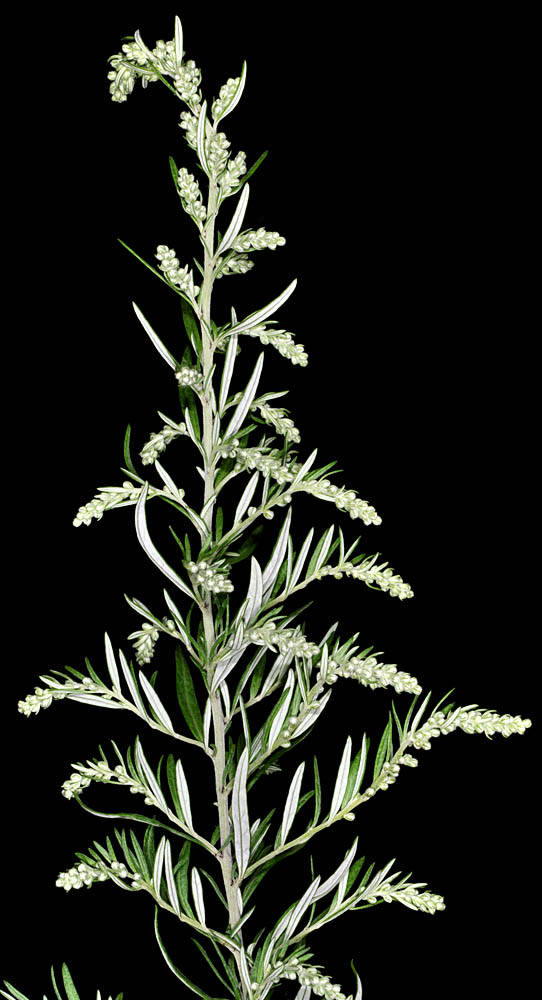
Herbs perennial, 5–15 dm; rhizomes elongate.
Stems glabrous or tomentose.
Leaves cauline, 2–12 cm, regularly or irregularly pinnately lobed, lobes toothed or again lobed, tips acute, surfaces abaxially glabrous, adaxially glabrous or tomentose; sessile or petiolate.
Inflorescences panicle-like.
Heads disciform, erect; sessile or peduncled.
Involucres cylindric or campanulate, 3–4 mm.
Phyllaries in several equal or unequal series, lanceolate or oblong, outer gradually shorter or sometimes exceeding inner, margins membranous, tips acute or obtuse, surfaces tomentose.
Receptacles glabrous.
Florets 20–30, outer pistillate, inner bisexual.
Fruits 0.5–1.2 mm, glabrous, sometimes resinous.
2n=18, 36, 40, 44.
Disturbed areas. Flowering Jun–Oct. 0–2000 m. Casc, WV. ID, WA; widely scattered in North America; Asia, Europe. Exotic.
as described under Artemisia vulgaris
Perennials, (40-)60-190 cm, sometimes faintly aromatic (rhizomes coarse). Stems relatively numerous, erect, brownish to reddish brown, simple proximally, branched distally (angularly ribbed), sparsely hairy or glabrous. Leaves basal (petiolate) and cauline (sessile), uniformly green or bicolor; blades broadly lanceolate, ovate, or linear, (2-)3-10(-12) × 1.8-8 cm (proximal reduced and entire, distal pinnately dissected, lobes to 20 mm wide), faces pubescent or glabrescent (abaxial) or glabrous (adaxial). Heads in compact, paniculiform or racemiform arrays (10-)20-30(-40) × (5-)7-15(-20) cm. Involucres ovoid to campanulate, 2-3(-4) mm. Phyllaries lanceolate, hairy or glabrescent. Florets: pistillate 7-10; bisexual (5-)8-20; corollas yellowish to reddish brown, 1.5-3 mm, glabrous (style branches arched-curved, truncate, ciliate). Cypselae ellipsoid, 0.5-1(-1.2) mm, glabrous, sometimes resinous. 2n = 18, 36, 40, 54.Flowering mid summer-late fall. Sandy or loamy soils, forested areas, coastal strands, roadsides; 0-500 m; introduced; Greenland; Alta., B.C., Man., N.B., Nfld. and Labr. (Nfld.), N.S., Ont., P.E.I., Que., Sask.; Ala., Alaska, Conn., Del., D.C., Fla., Ga., Idaho, Ill., Ind., Iowa, Kans., Ky., La., Maine, Md., Mass., Mich., Minn., Mo., Mont., N.H., N.J., N.Y., N.C., Ohio, Oreg., Pa., R.I., S.C., Tenn., Vt., Va., Wash., W.Va., Wis.; Eurasia.Grown as a medicinal plant, most commonly as a vermifuge, Artemisia vulgaris is widely established in eastern North America and is often weedy in disturbed sites. Populational differences in morphologic forms are reflected in size of flowering heads, degree of dissection of leaves, and overall color of plants (from pale to dark green), suggesting multiple introductions that may date back to the first visits by Europeans. It is tempting to recognize the different forms as subspecies and varieties; the array of variation in the field is bewildering. If genetically distinct forms exist in native populations, the differences appear to have been blurred by introgression among the various introductions in North America. A case could be made for recognizing var. kamtschatica in Alaska based on its larger heads and shorter growth form; apparent introgression with populations that extend across Canada confounds that taxonomic segregation.